
Some of the adverse effects seen in patients who use AASs may include infertility, gynecomastia, sexual dysfunction, hair loss, acne, muscular appearance, and testicular atrophy. Some indicators that might suggest AAS use are increased hemoglobin and hematocrit; suppressed LH, FSH, and testosterone levels; low high-density lipoprotein cholesterol, and low sperm density. Mass spectrometry-based tests (available in many commercial laboratories) can detect AASs in urine. Testosterone abuse is more difficult to detect, but high testosterone, in association with suppressed LH and FSH levels, should raise suspicion of testosterone abuse. A T/E ratio of more than 4 can confirm testosterone abuse, although it is rarely necessary to check testosterone levels in the clinical setting. Often direct questioning will result in an admission by a patient that he or she is using AASs.
Australia should stop beefing up its steroid laws – that won’t help users
Topics are selected on the basis of their emerging scientific impact on disease and their clinical relevance to the general population. Scientific Statements are developed by a multidisciplinary Task Force of experts with representation from several committees within the Endocrine Society. Creatine is the most popular nutritional supplement, accounting for $400 million in sales annually. Despite recommendations against creatine use in adolescents under age 18 years, its use is still common.

Prescription Performance-Enhancing Drugs

This article examines the complexity of these issues within the world of professional golf, major league baseball, and Olympic competition. ” and “When does restorative function end and performance enhancement begin? An article by Johnson et al17 thoroughly describes how these frameworks apply to this population in a clinical setting. The authors argue that many athletes who are https://ecosoberhouse.com/ contemplating or currently use PEDs require intervention methods that match their specific needs and readiness to change. These individuals do not respond to coercion or persuasion, so using MI to help the athlete identify discrepancies between their behavior (or contemplated behavior) and their values, motives, and interests may be more effective in the behavior change process.
- When individuals use performance-enhancing substances to gain an unfair advantage, it undermines the integrity of the competition.
- We also added to the reference list any additional references that were known to the members of the writing group but did not appear in this search.
- In a rigorously conducted study, highly trained cyclists were administered EPO or a placebo.
- I’ve always loved that freedom aspect of cycling, you know, the first time I could get away from mom and dad on my bike and travel many towns away from home.
- The physical and psychological adverse effects of anabolic androgenic steroids (e.g., kidney and liver damage, acne, gynecomastia, suppression of normal testosterone production, aggression, depression) are well established.
Davante Adams: ‘There’s pros and cons’ to having no timeline on Raiders’ QB battle
- Despite inconclusive efficacy data and concerning safety data, the use of performance-enhancing drugs (PEDs) in the adolescent population is on the rise.
- One study shows 3.3% of high school students admit anabolic steroid use; another finds 8% of girls and 12% of boys report using products to improve appearance, muscle mass, or strength.
- Each year, the survey investigates substance abuse and use in ∼50,000 8th-, 10th-, and 12th-grade students.
However, the test may be negative if the sample is collected after 3 or 4 days of erythropoietin use, especially after administration of low doses. Direct detection of blood transfusions and ESAs (erythropoietin, novel erythropoiesis stimulating protein darbepoetin alpha, and continuous erythropoietin receptor activator) is often difficult. Performance Enhancing Drugs Therefore, there’s a growing trend toward monitoring biomarkers of erythropoiesis (hemoglobin, hematocrit, and reticulocytes) over time (for an individual athlete) and analyzing these data using analytical models to identify patterns suggestive of doping (396). This type of monitoring is referred to as the Athlete Biological Passport.
- Simply put, these techniques create ions which can be separated and identified by their mass to characterize and identify the metabolites present.
- Recent research, however, challenges the belief that EPO provides a significant performance boost.
- This metabolite is long-lived and can be detected 28 days after administration!
- The question should be asked if the use of an antidepressant in these situations is fair.
- It’s creatine, and it’s not a drug at all, at least according to the U.S.
Performance-enhancing substance
- That makes it extremely tricky for regulatory agencies like the International Cycling Union and the World Anti-Doping Agency (WADA) to keep up — and to keep drugs out of competing athletes.
- 17α-Alkyl substitutions render the molecule resistant to degradation; thus, 17α-alkylated androgens can be administered orally.
- In any case, they don’t undergo government safety standards and could be mislabeled or impure.
The likely adverse effects include edema, excessive sweating, myalgias and arthralgias, carpal tunnel syndrome, and diabetes (Table 2). Much of the information about potential adverse effects of rhGH use in supraphysiologic doses has been inferred from the studies of patients with acromegaly, a disease of excessive GH production with elevated GH levels at all times (usually for many years). Chemicals in this special class of steroids, which include testosterone, androstenediol, androstenedione, nandrolone and stanozolol, are credited with increasing muscle mass and strength, but drug tests can easily detect anabolic steroid abuse. The role of policymakers in addressing performance-enhancing substance use in bodybuilding cannot be overstated. Policymakers can help ensure that performance-enhancing substances are not widely available and that access to them is limited. This can be done by developing and implementing regulations restricting these substances’ sale and distribution.

Performance-enhancing drug (PED) use by children and teenagers rose sharply in the past decade. One study shows 3.3% of high school students admit anabolic steroid use; another finds 8% of girls and 12% of boys report using products to improve appearance, muscle mass, or strength. Pediatrics clinicians must monitor PED usage trends, screen perceptively, and offer anticipatory guidance.
A. Androgenic-anabolic steroid

Leave a Reply